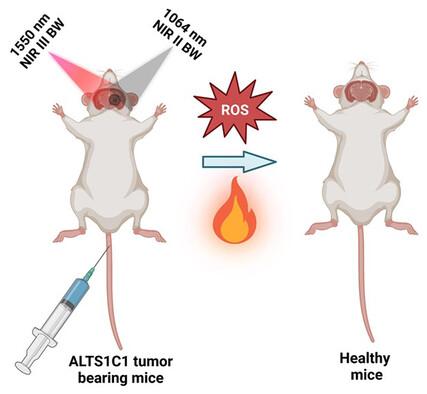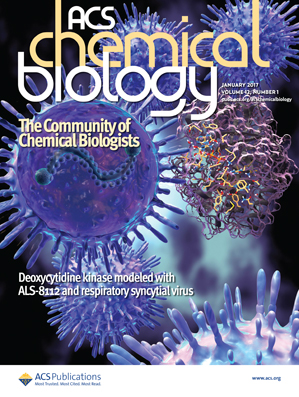肿瘤特异性纳米otheranostic制剂与核磁共振成像引导的近红外-II和-III光动力疗法共同对抗深位原位胶质母细胞瘤
IF 3.5
2区 生物学
Q2 BIOCHEMISTRY & MOLECULAR BIOLOGY
引用次数: 0
摘要
多形性胶质母细胞瘤(GBM)是侵袭性最强、最难治愈、最难治疗的恶性脑肿瘤之一,存活率极低。治疗多形性胶质母细胞瘤的金标准包括神经外科手术切除肿瘤,然后进行化疗和放疗。然而,这些策略对治疗 GBM 患者仍然无效,因为大多数情况下肿瘤总会复发。因此,如何开发出一种有效的策略来对抗正位胶质母细胞瘤,并同时利用成像功能来监测治疗效果,仍然是一项巨大的挑战。为了应对这一挑战,本研究首次证明了基于肿瘤特异性六硼化铕(EuB6)的纳米药物经 RGD-K 肽表面修饰后,可靶向胶质母细胞瘤细胞上过度表达的 αvβ3 整合素受体。此外,EuB6@RGD-K NPs 还能发挥治疗功能,利用近红外-II 1064 纳米和近红外-III 1550 纳米光动力疗法(NIR PDT)效应,有效诊断和治疗难以治疗的原位胶质母细胞瘤肿瘤。在体内实验中,用 EuB6@RGD-K NPs 处理并接受 NIR-III 1550 纳米光照射的小鼠的平均半衰期为 55 d,远高于接受 NIR-II 1064 纳米光照射的 EuB6@RGD-K NPs(25 d)、PBS 处理的小鼠(20 d)和 EuB6@RGD-K NPs 处理的小鼠(无光照射,18 d)。据我们所知,这项工作是首次通过多功能肿瘤特异性六硼化铕纳米吸附剂破坏小鼠脑肿瘤,从而介导磁共振成像引导的近红外-II/-III光动力疗法。本文章由计算机程序翻译,如有差异,请以英文原文为准。

Engineering Tumor‐Specific Nanotheranostic Agent with MR Image‐Guided NIR‐II & ‐III Photodynamic Therapy to Combat Against Deeply Seated Orthotopic Glioblastoma
Glioblastoma multiforme (GBM) is one of the most aggressive, incurable, and difficult‐to‐treat malignant brain tumor with very poor survival rates. The gold standard in treating GBMs includes neurosurgical resection of the tumor, followed by the chemotherapy and radiotherapy. However, these strategies remain ineffective in treating patients with GBMs, as tumor recurrence always occur in most cases. Therefore, it remains a grand challenge to develop an effective strategy to combat orthotopic glioblastoma with simultaneous imaging capabilities to monitor the therapeutic outcomes. To tackle this challenge, this study demonstrates, for the first time, that a tumor‐specific europium hexaboride (EuB6)‐based nanomedicine surface‐modified with RGD‐K peptide to target αvβ3 integrin receptors overexpressed on the glioblastoma cells. Further, EuB6@RGD‐K NPs are able to exert theranostic capabilities to effectively diagnose and combat difficult‐to‐treat orthotopic glioblastoma tumors using NIR‐II 1064 nm and NIR‐III 1550 nm photodynamic therapy (NIR PDT) effects. In the in vivo experiments, the average half‐life of 55 d for mice treated with EuB6@RGD‐K NPs and exposed to NIR‐III 1550 nm light irradiation is far higher than that of EuB6@RGD‐K NPs exposed to NIR‐II 1064 nm light irradiation (25 d), PBS‐treated mice (20 d) and EuB6@RGD‐K NPs‐treated mice (no light irradiation, 18 d). To the best of our knowledge, this work represents the first example for destructing murine brain tumors via multi‐functional tumor‐specific europium hexaboride‐based nanotheranostic agent to mediate MR imaging‐guided NIR‐II/‐III photodynamic therapy.
求助全文
通过发布文献求助,成功后即可免费获取论文全文。
去求助
来源期刊

ACS Chemical Biology
生物-生化与分子生物学
CiteScore
7.50
自引率
5.00%
发文量
353
审稿时长
3.3 months
期刊介绍:
ACS Chemical Biology provides an international forum for the rapid communication of research that broadly embraces the interface between chemistry and biology.
The journal also serves as a forum to facilitate the communication between biologists and chemists that will translate into new research opportunities and discoveries. Results will be published in which molecular reasoning has been used to probe questions through in vitro investigations, cell biological methods, or organismic studies.
We welcome mechanistic studies on proteins, nucleic acids, sugars, lipids, and nonbiological polymers. The journal serves a large scientific community, exploring cellular function from both chemical and biological perspectives. It is understood that submitted work is based upon original results and has not been published previously.
 求助内容:
求助内容: 应助结果提醒方式:
应助结果提醒方式:


